
30+ Master Gardener volunteers from 15 counties across the state, along with 7 Master Gardener program staff and faculty recently kicked off the first cohort of a task force focused on expanding diversity, equity, and inclusion in the OSU Extension Master Gardener Program. These volunteers have made an incredible personal volunteer commitment to serve on the task force for one year, and the faculty and staff are excited to work alongside them on this journey.
As a learning community we explore:
- our own stories and history
- history of racism in Oregon
- founding stories of land grant institutions
- colonization within the field of our work
- growing our awareness of inequities to improve our critical consciousness
As a working community we work to:
- Increase the diversity of who we serve in the community
- Increase the diversity of who we are in the program
- Grow the breadth of our curriculum and events to include cultural practices and inclusion
- Model inclusive practices to our peers in the MG program
- Form, grow and strengthen our work with community partners
We meet monthly to deepen our learning and to connect, and working sub groups are also running throughout the month. These four workgroups are focused on the following questions:
Who becomes a Master Gardener?
What are our current demographics?
What are the barriers to becoming a Master Gardener?
Barriers identified in previous surveys of MG volunteers and coordinators include:
-time required to take the course and to fulfill volunteer hours;
-cost of the training course and financial penalty for not completing volunteer hours;
-location of training course and volunteer opportunities;
-time of year/day when training course is offered.
Who do we serve in the community?
Mapping of where the MG Program currently works and operates
Using an asset-based approach, identify existing organizations and potential partners, groups and communities working in areas of the community where we are not.
How can our Master Gardener curriculum and content grow to be more inclusive?
Examining existing MG curriculum and making recommendations on how the MG curriculum can be broadened beyond a Euro-centric perspective that assumes land access and ownership. Should and how do we include different cultural perspectives in the curriculum?
What events and programming should we grow/develop to support this work?
Identify and plan special events, such as OSU Martin Luther King, Jr. Day of celebration, Pride and others as identified by subgroup. Coordinate and plan the Culture of Gardening series.
Why a DEI Task Force?
In 2020, we made clear statements and reiterated our commitment to building a more inclusive program. We know that these changes cannot be made without Master Gardener volunteers playing a key role in identifying and doing the work alongside us, as a way to engage and demonstrate, and to hold each other accountable. We have work to do, and we are committed to doing it together.



BRAVO!
This is important work, and it’s definitely time for MG to consider questions such as these. Thanks to all of you for moving us all to consider diversity, equity, and inclusion in how we live our lives together,
BRAVO
It has been a pleasure to serve on the task force. I have learned new information and broadened my awareness of bias in my everyday life.
The term JEDI should not be used for this or any other social justice work. First, the term JEDI is connected to many stereotypes, not the least of which is that the Jedi are a religious order of intergalactic police-monks, prone to (white) saviorism and toxically masculine approaches to conflict resolution (violent duels with phallic lightsabers, gaslighting by means of “Jedi mind tricks,” etc.). These are hardly appropriate mascots encouraging diversity and inclusivity.
Second, JEDI connects justice initiatives to corporations, at least one of which is noted for circulating racist, sexist, heterosexist and Orientalist narratives and imagery.
Third, The abbreviation JEDI can distract from justice, equity, diversity and inclusion. When you think about the word JEDI, what comes to mind? Chances are good that for many, the immediate answer isn’t the concept “justice” (or its comrades “equity,” “diversity” and “inclusion”). Instead this acronym likely conjures a pageant of spaceships, lightsabers and blaster-wielding stormtroopers.
Surely, the people involved in this work can come up with a tag-line or acronym — if they feel it’s necessary — for this important work that doesn’t come with all this baggage.
Want to read more? I paraphrased/copied this Scientific American article because it was laid out far better than I could have done on my own.
https://www.scientificamerican.com/article/why-the-term-jedi-is-problematic-for-describing-programs-that-promote-justice-equity-diversity-and-inclusion/
Hi Elwyn,
Thank you for taking the time to share your thoughts on the use of the acronym ‘JEDI’ to describe the work of our task force. I especially appreciate your providing a link to the Scientific American editorial. The opinions in the editorial are thought-provoking and important to hear/consider.
To be frank, we’ve struggled with what to call ourselves. Acronyms offer an expedient way to refer to our group . . . but acronyms are also inherently exclusionary. Unless you’re part of the ‘in group’, you likely won’t know what the acronym means.
Yet, we’ve waffled between the acronyms DEI and JEDI, despite the limitations of acronyms for diversity and equity work.
All of this is to say that I still struggle with what to call our group, and what to call this work . . . but I hear you and I appreciate you taking the time to write out your concerns. We convene the second cohort of our task force in April of 2022 . . . only one short month away. It’s the perfect time to revisit our name, and how we refer to our work.
~Gail